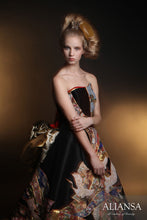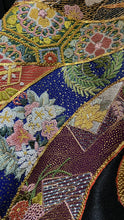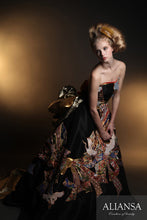A dress casually detailed with hand-embroidered parts combined with the base material. When looking from up close, you can clearly see that the patterns are all Sagara embroidery (hand embroidery).

Depicted along with the crane is a Noshi pattern that symbolizes joy.
All the patterns are embroidered with Sagara embroidery (embroidery with gems) by craftsmen who put their heart and soul into each and every stitch.
▽Name of the pattern on the dress/Benefit▽
Flying Crane and Bundled Noshi Pattern
Since the Edo period, the Noshi pattern has symbolized blessings, and the flying crane pattern has been associated with good fortune and longevity. They can be used to express wishes and prayers for happiness.
▽Explanation of the pattern used▽
Bundled Noshi Pattern
Noshi originated as thin slices of abalone flesh that were stretched and dried, called Noshi abalone, and used as a preserved food. Since who-knows-when, it was folded long and thin, wrapped in beautiful paper, and used as a sign of congratulations. Since the Edo period, it has also been used as an auspicious pattern in dyes and weaves.
Flying Crane Pattern
A type of crane pattern in which a flying crane is depicted is called the flying crane pattern. Cranes are said to live for a thousand years, so they can be used to express prayers for longevity. Cranes are also said to bring good luck and great fortune as they fly towards the sky.








